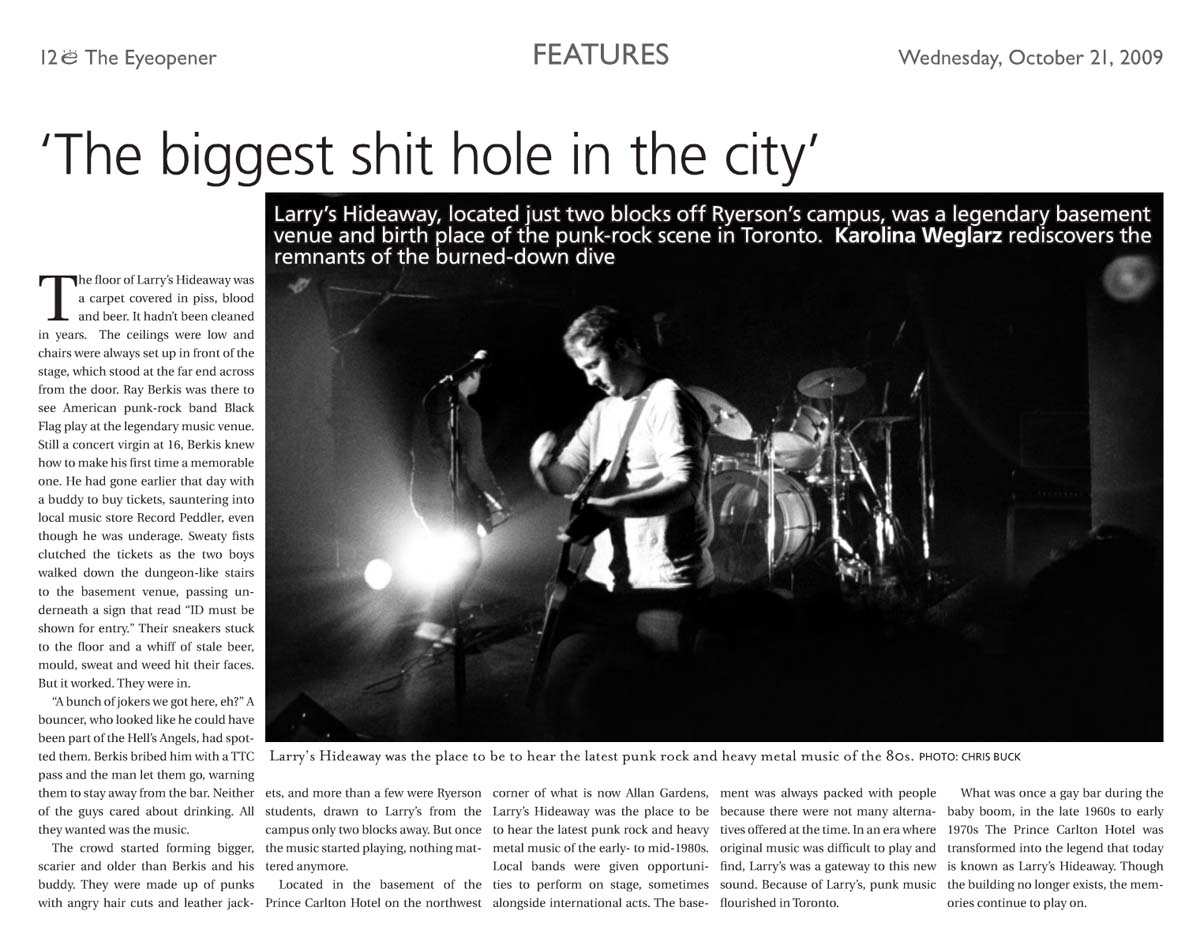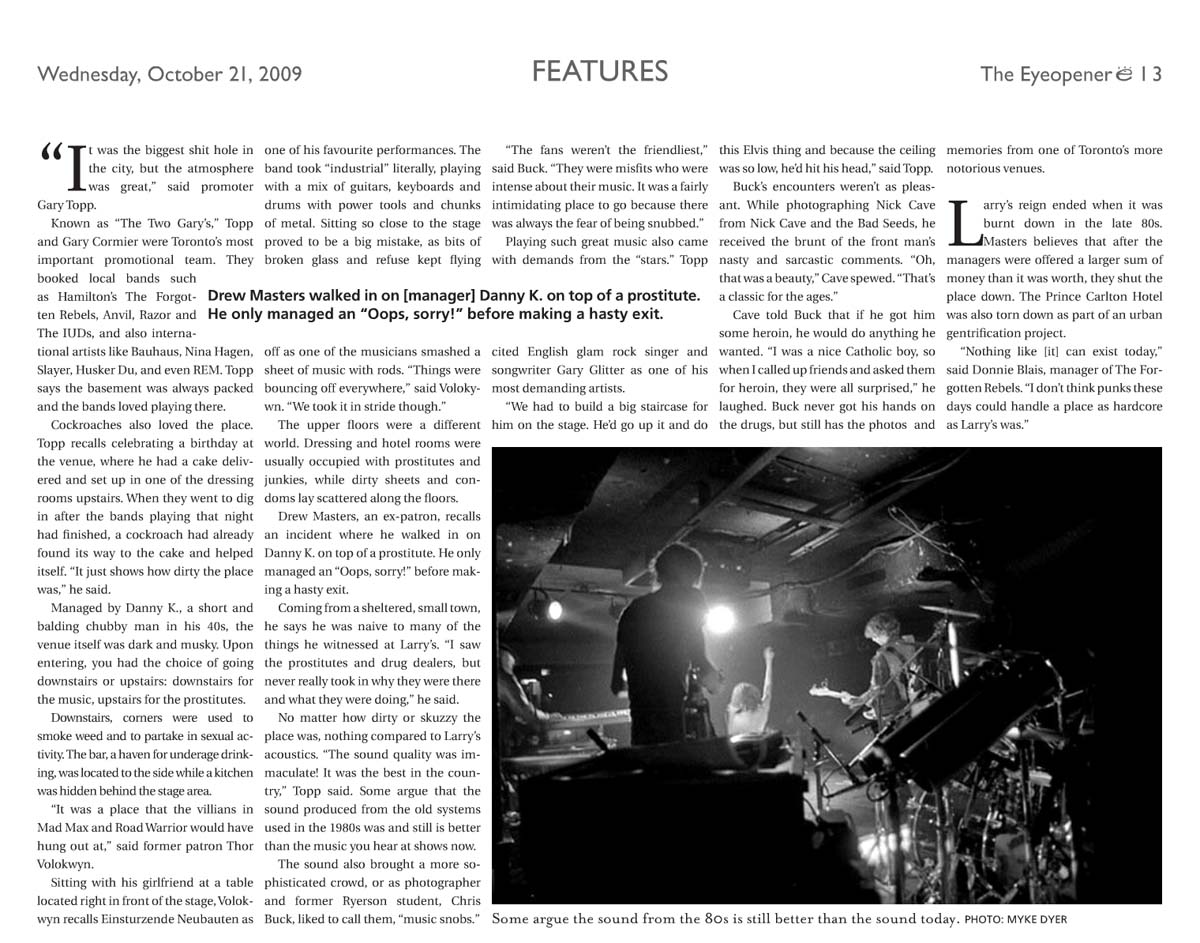

|
The Eyeopener is the independent student newspaper of Ryerson
University in Toronto.
This issue featured an article reminiscing about Toronto's long-lost
punk venue, Larry's Hideaway, and included a
couple of
photos of Hüsker Dü performing there on 02 May 1985. The
article, written by Karolina Weglarz, is reproduced below via
screen captures. Text transcription follows. Photo credits: Myke Dyer, Chris
Buck.
|


|
|
The floor of Larry's Hideaway was a carpet covered in piss, blood and beer. It hadn't been cleaned in years. The ceilings were low and chairs were always set up in front of the stage, which stood at the far end across from the door. Ray Berkis was there to see American punk-rock band Black Flag play at the legendary music venue. Still a concert virgin at 16, Berkis knew how to make his first time a memorable one. He had gone earlier that day with a buddy to buy tickets, sauntering into local music store Record Peddler, even though he was underage. Sweaty fists clutched the tickets as the two boys walked down the dungeon-like stairs to the basement venue, passing underneath a sign that read "ID must be shown for entry." Their sneakers stuck to the floor and a whiff of stale beer, mould, sweat and weed hit their faces. But it worked. They were in. "A bunch of jokers we got here, eh?" A bouncer, who looked like he could have been part of the Hell's Angels, had spotted them. Berkis bribed him with a TTC pass and the man let them go, warning them to stay away from the bar. Neither of the guys cared about drinking. All they wanted was the music. The crowd started forming bigger, scarier and older than Berkis and his buddy. They were made up of punks with angry hair cuts and leather jackets, and more than a few were Ryerson students, drawn to Larry's from the campus only two blocks away. But once the music started playing, nothing mattered anymore. Located in the basement of the Prince Carlton Hotel on the northwest corner of what is now Allan Gardens, Larry's Hideaway was the place to be to hear the latest punk rock and heavy metal music of the early- to mid-1980s. Local bands were given opportunities to perform on stage, sometimes alongside international acts. The basement was always packed with people because there were not many alternatives offered at the time. In an era where original music was difficult to play and find, Larry's was a gateway to this new sound. Because of Larry's, punk music flourished in Toronto. What was once a gay bar during the baby boom, in the late 1960s to early 1970s The Prince Carlton Hotel was transformed into the legend that today is known as Larry's Hideaway. Though the building no longer exists, the memories continue to play on. "It was the biggest shit hole in the city, but the atmosphere was great," said promoter Gary Topp. Known as "The Two Gary's," Topp and Gary Cormier were Toronto's most important promotional team. They booked local bands such as Hamilton's The Forgotten Rebels, Anvil, Razor and The IUDs, and also international artists like Bauhaus, Nina Hagen, Slayer, Husker Du, and even REM. Topp says the basement was always packed and the bands loved playing there. Cockroaches also loved the place. Topp recalls celebrating a birthday at the venue, where he had a cake delivered and set up in one of the dressing rooms upstairs. When they went to dig in after the bands playing that night had finished, a cockroach had already found its way to the cake and helped itself. "It just shows how dirty the place was," he said. Managed by Danny K., a short and balding chubby man in his 40s, the venue itself was dark and musky. Upon entering, you had the choice of going downstairs or upstairs: downstairs for the music, upstairs for the prostitutes. Downstairs, corners were used to smoke weed and to partake in sexual activity. The bar, a haven for underage drinking, was located to the side while a kitchen was hidden behind the stage area. "It was a place that the villians in Mad Max and Road Warrior would have hung out at," said former patron Thor Volokwyn. Sitting with his girlfriend at a table located right in front of the stage, Volokwyn recalls Einsturzende Neubauten as one of his favourite performances. The band took "industrial" literally, playing with a mix of guitars, keyboards and drums with power tools and chunks of metal. Sitting so close to the stage proved to be a big mistake, as bits of broken glass and refuse kept flying off as one of the musicians smashed a sheet of music with rods. "Things were bouncing off everywhere," said Volokywn. "We took it in stride though." The upper floors were a different world. Dressing and hotel rooms were usually occupied with prostitutes and junkies, while dirty sheets and condoms lay scattered along the floors. Drew Masters, an ex-patron, recalls an incident where he walked in on Danny K. on top of a prostitute. He only managed an "Oops, sorry!" before making a hasty exit. Coming from a sheltered, small town, he says he was naive to many of the things he witnessed at Larry's. "I saw the prostitutes and drug dealers, but never really took in why they were there and what they were doing," he said. No matter how dirty or skuzzy the place was, nothing compared to Larry's acoustics. "The sound quality was immaculate! It was the best in the country," Topp said. Some argue that the sound produced from the old systems used in the 1980s was and still is better than the music you hear at shows now. The sound also brought a more sophisticated crowd, or as photographer and former Ryerson student, Chris Buck, liked to call them, "music snobs." "The fans weren't the friendliest," said Buck. "They were misfits who were intense about their music. It was a fairly intimidating place to go because there was always the fear of being snubbed." Playing such great music also came with demands from the "stars." Topp cited English glam rock singer and songwriter Gary Glitter as one of his most demanding artists. "We had to build a big staircase for him on the stage. He'd go up it and do this Elvis thing and because the ceiling was so low, he'd hit his head," said Topp. Buck's encounters weren't as pleasant. While photographing Nick Cave from Nick Cave and the Bad Seeds, he received the brunt of the front man's nasty and sarcastic comments. "Oh, that was a beauty," Cave spewed. "That's a classic for the ages." Cave told Buck that if he got him some heroin, he would do anything he wanted. "I was a nice Catholic boy, so when I called up friends and asked them for heroin, they were all surprised," he laughed. Buck never got his hands on the drugs, but still has the photos and memories from one of Toronto's more notorious venues. Larry's reign ended when it was burnt down in the late 80s. Masters believes that after the managers were offered a larger sum of money than it was worth, they shut the place down. The Prince Carlton Hotel was also torn down as part of an urban gentrification project. "Nothing like [it] can exist today," said Donnie Blais, manager of The Forgotten Rebels. "I don't think punks these days could handle a place as hardcore as Larry's was." |
Back to Hüsker Dü magazine articles page
Back to Hüsker Dü database main page